Events from Jan 79 to Nov 80
The Third Coming
Graham Williams had become the producer of Doctor Who for the 15th season and in 1978 he was planning his final year – season 17. Williams had to cope with many pressures during his time on the show, including orders from above to tone down the more violent aspects of the show, budget cuts and an increasingly difficult main star.
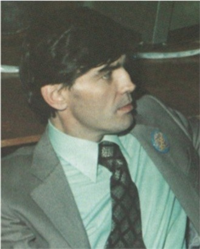
Graham Williams
To help him though his last season, Williams appointed Douglas Adams to be his script editor. Adams was a radio and television writer who had contributed The Pirate Planet to the previous season and written a radio play broadcast earlier in the year entitled The Hitchhiker’s Guide to the Galaxy. This had gone down well and lead to the commission of another radio instalment scheduled for Christmas.
Having avoided the use of the Daleks for his first two seasons, Williams decided that the four years since their last appearance was enough, and he wanted to use them as a strong season opener to hook in viewers. Williams and Adams approached Terry Nation during November 1978, and although Nation was very busy with his own sci-fi creation Blake’s 7, he was very interested in writing another Dalek tale.
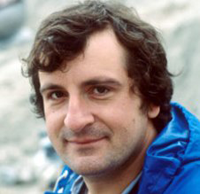
Douglas Adams
Williams and Adams suggested borrowing a storyline by Isaac Asimov as a starting point, in which two space fleets were locked in a logical stalemate, deadlocked until a random act is performed. Nation liked the idea but had two caveats. First, he wanted to re-use Davros -whose death on screen had been slightly ambiguous in Genesis of the Daleks – and second he was not keen to use K-9 whom he felt would upstage his own creations.
His concessions were agreed to and the scripts were commissioned on 20th December 1978, just as Douglas Adam’s Christmas special for The Hitchhiker’s Guide to the Galaxy was broadcast.
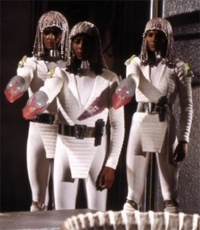
The Movellans
Nation’s heavy workload meant that the serial would have to go third into the production order despite the fact it was to be shown first. The draft scripts arrived one week after the target date of 19th January 1979. Nation’s work was changed very little during the production process but Douglas Adams did include a few humorous scenes of his own. The controversial regeneration scene was hastily added by Adams when Mary Tamm chose not to return to play Romana and Adams also scripted the line in which the Doctor taunts the Daleks for not being able to climb.
The nature of the robot-empasse storyline forced Nation to slightly twist his Dalek creations to fit the concept, and thus it was implied that they were now more robotic than the earlier generations. Set against them, he created the ‘perfect’ robots, The Movellans, as the Daleks’ logical enemy.
Ken Grieve was appointed to direct Destiny of the Daleks and would be his only work on the show. Although many people on set had found Baker to be difficult and hard to work with, Grieve formed a good relationship with the star.
The Raggedy Daleks
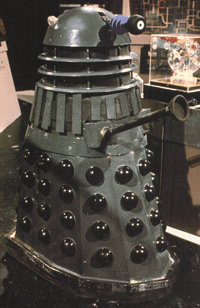
The lead Dalek, Dalek v-vi
As soon as it was known that the Daleks would feature in the 17th season of Doctor Who, Peter Logan of the BBC’s Visual Effects Department set to work on recalling and accounting for the Dalek props. Unfortunately he found a very battered collection of Daleks at his disposal, due to three years at the hands of the public and other TV productions teams.
From October 1978, the Visual Effects department had been assembling the army as best they could and had set about refurbishing and repairing the best sections. Such was the varied provenance of the components at this stage, little was understood about how the parts were originally paired up, and consequently Goon elements were freely mixed with the Shawcraft sections. The varying types of lights on the props are evidence of how little time or money was available as no importance was given to uniformity. The three-stage arms of the original Shawcraft Daleks were now a thing of the past, and only two-stage arms would be used – if that.
The only component to really buck the trend of neglect was the dome. All four props were installed with a new ‘A’-frame turning mechanism, which was mounted in the neck and allowed the head to spin on top. The pivot protruding through the dome was often explained away by fans as an antenna and even made the Sevans model Dalek notes as such. The new frames sometimes lifted the dome higher off the neck and so the neck cages were pulled up to compensate, resulting in the upper half of the props appearing improperly fitted together.
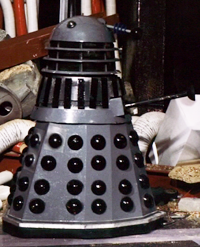
Dalek iv-ex showing the vac-formed hemisphere
Of the four props assembled, the lead Dalek was a hybrid of Goon halves making a prop termed Goon v-vi. This was the only prop to retain its darker grey finish of Genesis of the Daleks and although no Dalek was specifically referred to as a leader this individual appeared to give orders throughout the story. The reasonable condition of this casing, its lack of repainting and its absence from publicity photos of the last few years suggests it had been in storage.
The Exhibition skirt was given its Doctor Who TV debut paired up as usual with the shoulders of Goon iv. This prop had earlier featured on an episode of Nationwide in which Jon Pertwee was promoting his new book. For Destiny of the Daleks, one of the ‘Shawcraft style’ neck cages and original dome were swapped onto Goon iv-ex. A small ‘U’ shaped attachment was inserted into the pivot slot of the dome to prevent the eye from dropping too far downwards. Further evidence of careless refurbishment can be seen on Dalek iv-ex’sMeaning 1skirt which had vacuum-formed hemispheres hastily stuck to the outside where the original hemispheres were missing.
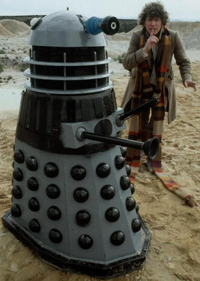
Dalek Seven-ii on location with Tom Baker
Shawcraft prop Dalek Six-5 had appeared painted entirely gold a few months earlier on Pebble Mill to celebrate the 500th episode of Doctor Who. Structurally, the prop was relatively unchanged from its last appearance although it now had a different Goon dome.
The top of Dalek Seven was given a Goon neck cage and dome but, due to the disappearance of Dalek Two’s skirt, it had become paired with Goon ii’s skirt at the Worthing Carnival in 1978 and now formed Dalek Seven-ii.
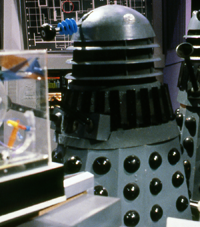
Dalek Six-5 with its distinctive set of skirt bolts
Unlike the main all-grey goon prop, the latter three other Daleks were painted a lighter grey colour with various parts finished in black, giving the cast of aliens a degree of hierarchy. In truth, the first repainting of the props occurred circa October 1978 (for Dalek iv-ex’s appearance on Nationwide) and so it seems more likely the choices were actually random. All four were given new eyestalks with a diminished number of discs. Dalek One’s severely damaged shoulders could not be used and these were placed into storage along with the the intact skirt of Dalek Seven, still in their gold and silver liveries at this time.
In addition to the hero props, six complete vacuum-formed Daleks were created. Five were to be used on location and one was to be blown up in studio. They were really only suitable for extreme long-shots but still ultimately came into play in studio scenes and were often seen too close to the camera where they were shown up as being extremely roughly made.
The Raggedy Davros
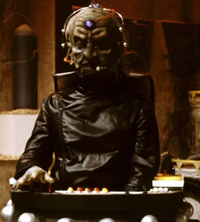
Davros
Due to the unavailability of Michael Wisher, David Gooderson was cast to play Davros. Gooderson was of similar build to Wisher although due to a difference in head-size, the original mask was quite ill fitting. John Friedlander, the original mask-maker, had too little time and no budget to create a new mask from scratch, so the mouth section was removed and a thick makeup alternative was used to fill in, although this had the unfortunate effect of giving little mouth movement and ruined the look of the mask. Minor work was carried out to the chair from Genesis of the Daleks, which included the fender being painted black.
Two Quarries!
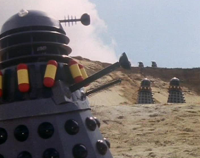
Dalek Six-5 and the vac-formed props on location
Doctor Who was famous for its use of quarries during its history but Destiny would push the boat out and use two. Location filming started Monday 11th June 1979 in ARC’s Winspit Quarry, Worth Matravers, near Swanage, and also used ARC’s pit in Binnegar Heath near Wareham. Filming would alternate between these locations until the 15th.
Three Daleks were taken on location, these being, Dalek iv-ex, Dalek Six-5 and Dalek Seven-ii and the team laid boards on which the Daleks could move more easily. The Goon skirt of Dalek Seven-ii was showing a pronounced split in one of its front panels, and this can clearly be seen in the mine scenes and the scenes where the Doctor hides in a crevice shortly before finding the Kaled Mutant.
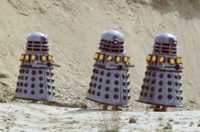
The vac formed Daleks were carried by extras
In addition to the main three props, the five vacuum-formed dummies were employed. These were extremely lightweight and were used for the scenes of the Daleks suicide attack on the Movellan craft. Extras literally hoisted up the props and ‘walked them’ along, resulting in motion that was neither smooth nor convincing. The dummies were also used for the set-up to the Daleks’ destruction, whereby the five props were filmed from several angles and two were genuinely blown up, with quick editing used to hide the fact that three were removed before the pyrotechnics went off.
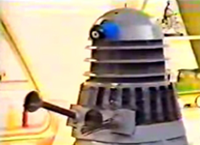
Dalek Six-5 in the Blue Peter studio in 1979
At the end of location filming the Daleks were given a little refurbishment, and before studio taping was due to begin on the rest of Destiny, the Daleks were requested to appear on other BBC programme’s.
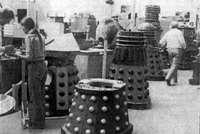
The Daleks in preparation at the Visual Effects Dept.
On 21st June, Dalek Six-5 was a guest on Blue Peter. Richard Berelson was showing off his home made Dalek and the Shawcraft original was brought in to compare to his own work. Despite being unavailable for the actual recording of Destiny of the Daleks, John Scott Martin operated the prop and, as he had for the Weetabix advert, voiced it too.
Two Daleks were also requested for internal BBC educational shows. By the time the props reached the studio for Doctor Who use they were already worse for wear again.
Studio Splits
Studio taping began on 2nd July 1979. Grieve elected to use a trick that Richard Martin had used many years ago in Daleks Invasion of Earth, whereby he generally kept the camera in low positions to make the props more domineering.
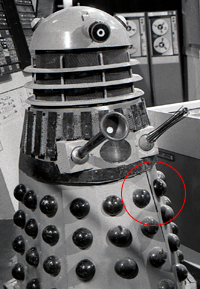
Dalek Seven-ii with its skirt split
Most of the props’ work in the story was standard Dalek fare, but under the studio lights it was easy to see the deterioration that had happened in the previous few years. Dalek Seven-ii’s skirt still showed the split and had not been repaired since location filming, and there were several instances on the shoulders lifting from the skirts as the Daleks moved.
Throughout all the taping, lead Dalek v-vi had an additional silver plate added to the right-hand side of its skirt. This was only used for one very brief section of the story when the Doctor attaches a magnetic bomb to its side. It was an effect that could have easily been achieved with an adhesive and saved the bother of attaching the unsightly and rather obvious silver plate. The scene also called for the sixth vac-formed Dalek to appear, although this one was was designed to fall apart on the detonation of its explosives.
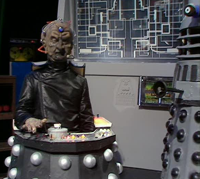
Davros is flanked by a vac-formed Dalek
Three of the other vac-formed Daleks had been salvaged from location work, and these were used in the Dalek control room to bolster numbers during the scenes of Davros commanding the Daleks to their suicide. The scene unfortunately concludes with one of the poorly made props pushed into position behind Davros.
Taping concluded on 17th July, and the Dalek props were returned to storage. It would only be a matter of days until they were required again.
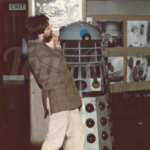
The complete Dalek Seven at Panopticon in 1979. Picture: Matthew Doe – Toybox Treasures. Click for a larger view.
In August, the Doctor Who Appreciation Society held their third convention ‘Panopticon 3’ at the Imperial College in London. Amongst all the distinguished guests was a rather dishevelled looking Dalek prop that was used onstage during the various events and also mingled with the fans during the day. However, despite its sad appearance, it was actually quite a notable Dalek in that it was the complete Dalek Seven. The sections had been reunited for the first time since the 1960s. The shoulders had recently been used during the taping of Destiny but the skirt had been in storage during this time hence it was still in its silver and black livery of its last appearances out on loan at various events.
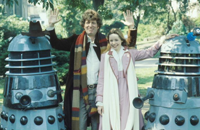
Dalek Seven-5 and Dalek iv-ex at the photocall
With the new season due to start on 1st September, two Dalek props were called up for a promotional photocall on 30th August. Dalek iv-ex and a new combination of Dalek Seven-5 were brought together to star along side Tom Baker and Lalla Ward. It was obvious that Dalek Seven’s shoulders were never made to match with Dalek Five’s skirt as they can be seen balancing precariously throughout the series of pictures.
The Third Hiatus
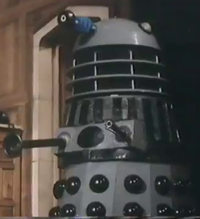
Dalek Seven-5 recites Shakespeare
After the broadcast of Destiny of the Daleks it would be another 5 years before the Daleks would see a full adventure again, and during that gap their TV cameos would be far more sparse than in previous years without Dalek stories. One exception was on the 10th April 1980. Dalek Seven-5 made a brief appearance in an instalment of James Burke’s The Real Thing. James Burke was a science historian and this particular episode focused on Perception. In the skit the Dalek had to audition for Shakespeare but James Burke was able to perceive it was not human.
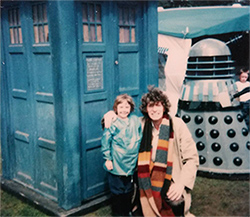
Dalek One-5 at the Bushey Show. Picture – Jackie Rogers.
1980 also saw Tom Baker sensationally decide to leave his part of The Doctor after seven years. He had been the longest-serving actor in the role and his departure was big news. All sorts of speculation ensued about who would take over, and even rumours of a female lead were circulated.
Even nearing the end of his time on the show, Baker was still making public appearances. A fortuitous friendship between a member of the Bushey and Oxhey Round Table and an employee of BBC Enterprises meant that Baker, the Tardis and a number of monsters were able to attend a fund raising event for the Round Table organisation during 1980. The Dalek prop on show that day included the patched up shoulders of Dalek One. The boxes had been strengthened with wooden cladding which had the effect of making them slightly larger and creating double-staged socket similar to Dalek Seven’s. The slats had been reduced in number since Genesis of the Daleks and two blocks were added beneath the upper collar between the gun and arm boxes. A strengthening wooden surface was applied to the whole underside of the shoulders which made them sit up high on top of the skirt, which in this case was Dalek Five’s.
Before he left, Tom Baker was given a send off by Madame Tussauds, the world famous waxwork makers. Doctor Who was to be given a section for itself featuring not only Tom Baker, but several of the show’s monsters including a Sontaran, a Foamasi, and Meglos amongst others. The inclusion of Meglos meant that Tom Baker was the first person to have two likenesses at the same time at Madame Tussauds in its long history. No exhibition would be complete without a Dalek of course, and the prop chosen would go on to be arguably the most famous Dalek in the show’s history.
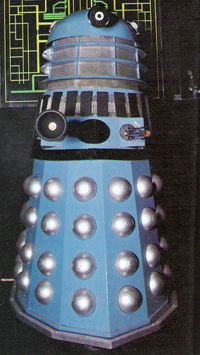
Dalek Six-ex on display at Madame Tussauds
Dalek Six’s shoulders, neck and dome were paired to the Exhibition skirt to become Dalek Six-ex, A disc was added to the top of the dome which sat around the pivot and the lights were replaced. Despite Madame Tussauds being a showcase for mimicry, the prop was inexplicably painted in a light blue finish with silver and black highlights – a colour scheme totally unheard of in the entire history of the programme. At some point during its stay the lights were changed again to the more usual ‘sidelight’ type although these were encircled by discs similar to that of the new addition on top of the dome.
The exhibition opened on the 29th August 1980 and despite being due to finish in March 1981, it was extended to 1982 due to popularity.This public exposure of this distinctive prop meant it soon became known as the Tussauds Prop.
In November, actor Peter Davison, famous for his part in All Creatures Great and Small, was cast as the new Doctor and a round of personal appearances followed. One such showing was on Pebble Mill later that month. As usual with these the type of promotions, the actor was surrounded by a plethora of monsters from the show, and of course a Dalek had to make an appearance.
Having been repaired for its exhibition duties during its time off-screen, Dalek One’s shoulders were able to be reused on TV again for this important date, this time, matched with the skirt of Goon ii.
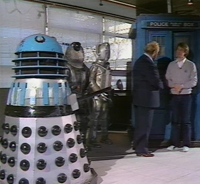
Dalek One’s shoulders reappear on Pebble Mill in 1980
The prop was given a bizarre colour scheme of silver, black and blue but still retained the gold oval from its previous livery. The same dome had been kept (with new eye and lights) but its original neck cage had been replaced by that of a goon. There was a fair amount of damage to the dome and one of the slats was already broken. Its appearance hinted at its hard life out on the road for hire. It had at least been given the new dome rotation system but it was a prop in a rather sorry state and a disappointing choice with which to hail in the new Doctor.
The 20th anniversary of Doctor Who was three years away, although preparations for the celebrations started well in advance. A huge convention was in the pipeline along with an anniversary special, and although the initial plans for the special included no Daleks, that would soon change…
Next Page: Twenty Years and The Five Doctors
-
Once components began to be mixed together, we had to find an easy short-hand to talk about the different props in their jumbled state. Since the upper half of a Dalek is both the most distinctive and the most frequently seen on camera, we keep this as the primary identifier and we append it with a dash and then a reference to the skirt, Hence with the original Shawcraft props Dalek One-7 means the top half of Dalek One, with the skirt of Dalek Seven underneath. However for the “Goons” built in 1973, we have given them Roman numerals in order to differentiate between them and the Shawcraft props. Hence Dalek v-5 is made of a mixture of the top of Goon v and the skirt of Dalek Five. But in this instance the “ex” suffix for the lower half refers to an oddball skirt most commonly associated with exhibitions, hence “ex” for short.
